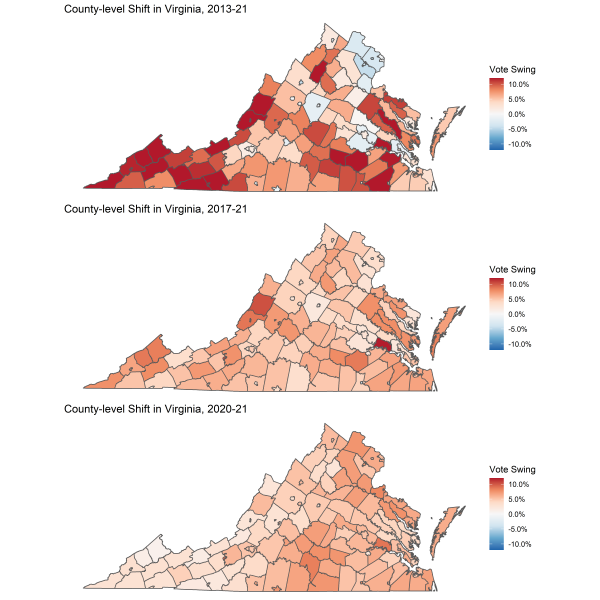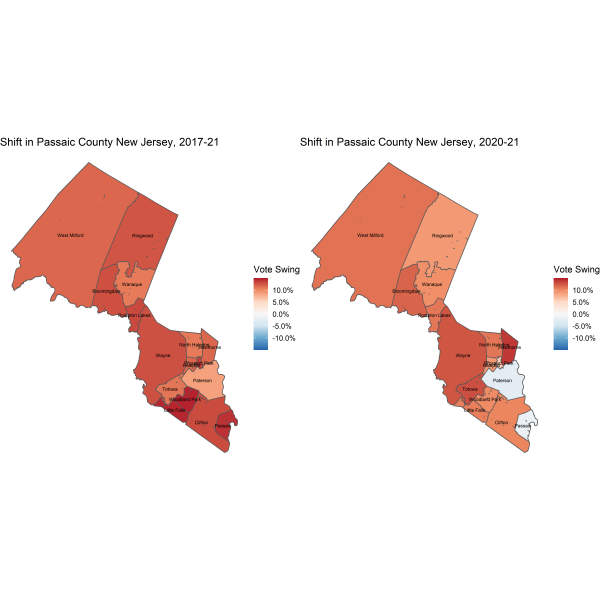Three Takeaways From Virginia and New Jersey

1. The Virginia results were bad news for Democrats.
Obviously, Terry McAuliffe’s loss to Glenn Youngkin was not the result Democrats in Virginia — and beyond — were hoping for. They lost all three statewide offices, and appear to have lost control of the House of Delegates (although they probably overperformed there, as they could have lost many more seats given their swelled rolls after shellacking Republicans in 2019).
What makes these losses so concerning is that Virginia is tailor-made for the emerging Democratic coalition. While there is still a healthy rural population in the Old Dominion, the state is dominated by its cities. In particular, the move toward Democrats over the past two decades has been driven by the party’s emerging strength nationally in mega-cities. Just as the swing in places like Texas and Georgia has been a result of Democratic gains among white suburbanites in places like Atlanta, Dallas and Houston, so too have the changes in Virginia been propelled by gains in the Northern Virginia suburbs; Richmond and the Hampton Roads areas have moved substantially toward Democrats as well.
In addition, the state has a substantial African American population. This provides a bedrock of support for the Democratic Party, at least in our current political alignment.
Democrats lost despite all of this. That is the most chilling aspect for them. If they can lose in a state that Joe Biden won by 10 points, in one of the most favorable demographic terrains in the country, then Senate seats in much more marginal places such as Arizona and Nevada suddenly look a lot shakier.
Remember also that Democrats won the popular vote for the House of Representatives by about two percentage points in 2020 (after accounting for unopposed seats). Needless to say, a swing away from them of the magnitude we saw in Virginia would be calamitous for them.
2. The results could have been much worse.
With that said, a more punishing fate was averted. First, recall that in 2009, Bob McDonnell won the governorship by 19 points, after Barack Obama had won the state by six. With McDonnell carrying Fairfax County, it looked as if Obama’s gains in the suburbs had been completely obliterated.
While this year’s swing of around 12 points away from Democrats in Virginia is not good news for the party, it is nevertheless about half the size of the swing from 2008 to 2009. Moreover, the basic Democratic coalition in the state remains intact; Fairfax is still Democratic.
If we examine things at the county level (remembering that some votes are still being counted), we see what looks like a uniform swing across the state vis-à-vis 2017 and 2020. (Click to enlarge the image.)

Nothing in particular sticks out. This is actually good news for Democrats, in a sense. If there had been a large swing against them in the suburbs compared to the rest of the state, it might suggest that Republican attacks on critical race theory in school curricula or disputes over transgender student bathroom choices had been taking their toll, and those arguments could be exported elsewhere.
Instead, we seem to see general dissatisfaction with the Democratic Party, spread across the state. This means that if things like inflation, economic growth, unemployment and COVID are back to “normal” by November 2022, Democrats will be in much better shape. I’m of the opinion that those matters are largely out of the parties’ hands, which isn’t great news for Democrats, but it is good news that things are also out of Republicans’ hands as well.
Note too that the movement from 2013 is about what we’d expect: Republicans have made big gains in rural areas, suggesting they have continued to hold onto Donald Trump’s numbers even without Trump on the ballot (in fact, the map is truncated at 15% movement in either direction, to keep Republicans’ rural gains from overwhelming the movement in other places). But the Democrats have held onto their gains from Northern Virginia, suggesting that Trump being off the ballot isn’t the panacea that some Republicans had hoped for.
3. The New Jersey results are much worse for Democrats.
If you want to see truly bad news for Democrats, we should look to the New Jersey governor’s race. Phil Murphy likely won his reelection battle, but it will be close in a state no one really expected to be close. This roughly 20-point swing from 2020 should be terrifying — and exhilarating for Republicans.
If we look at the swing from the 2017 gubernatorial race (which Murphy won) and the 2020 presidential race (which Biden won by about the same margin as Murphy’s in 2017), we can see some different themes emerging. As an initial note, though, be careful with the numbers from Essex County, as there are still a large number of ballots outstanding there; it will probably move toward Democrats as the count winds up.
Republicans made big gains from 2017, suggesting that they managed to hold onto Trump’s advantage among rural and working-class white voters. Comparing to 2020, we see big gains in blue-collar places like Mercer County (Trenton) and, to a lesser extent, Passaic. Note that the shifts in upper-class suburban counties like Morris are relatively subdued, suggesting again that there hasn’t been a “snap-back” without Trump on the ballot.

As a final thought, let’s look at Passaic County at the town level.

From 2017, the biggest Republican gains came in Passaic City, Prospect Park, Woodland Park, and Little Falls Township. These are among the most heavily Hispanic areas of the county, suggesting that Trump’s 2020 gains may last without him on the ballot, and even with a relatively obscure Republican running. From 2020, Hawthorne, Wayne and Totowa townships moved the most against Democrats. The shift in the blue-collar areas is consistent with continued movement toward Republicans among working-class whites. We should note again that the wealthier townships in the northwestern portion of the county showed more modest gains for Republicans compared to 2017 and 2020. This is consistent with the idea that the movement against Republicans in the wealthy suburbs from 2012 to 2020 is lasting.
But continued losses among blue-collar whites, combined with defections among Hispanic voters, is a potentially catastrophic outcome for Democrats in 2022. These are the results that should keep Democratic strategists awake at night.
Source: https://www.realclearpolitics.com/

